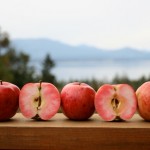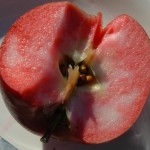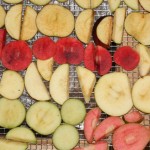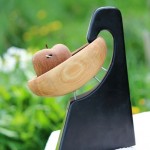Oh for a crunchy, juicy, tasty apple. MY KINGDOM for a great apple in June. The best keeping apples will only last here until about April, although controlled atmosphere apples from the Okanagan will last much longer.
So June and July are the most difficult time to get good apples, except if imported from the southern hemisphere, where apples are just now ripening, since their seasons are reversed from ours.
So this is the time to drool over a local, organic apple, raised just as Mother Nature would have wanted. No man made chemicals, nothing artificial, just the processes of Mother Nature which our bodies have evolved with over millennia. It is such a magical process, and while the orchardist might work 12 hours a day, Mother Nature is working 24 hours a day performing processes as intricate as symphonies, to bring that apple to perfection on that anticipated day when it is ripe.
1) For a study in pure apple enjoyment, watch this beautiful video of a pileated woodpecker enjoying a juicy Karamijn de Sonnaville at
The woodpecker portion starts at 2 minutes 22 seconds. You can see the delight the woodpecker is experiencing as he pecks away and the juice flies. I can tell by the enthusiasm of the woodpecker call, when it is eating an apple it likes. We do not try to scare them away, but just let them eat. We do record the varieties which they choose as they are one of our unpaid apple tasters. Gravenstein, Cox, Karamijn and Northern Spy are their perennial favourites, just as they are mine. Woodpeckers do not eat mediocre apples, they have the choice of 200 varieties here at Apple Luscious Organic Orchard.
Karamijn de Sonnaville is a late October ripening Cox Orange Pippins cross, from Holland in 1972. It has a beautiful sweet-tart flavour, is quite large and relatively trouble free and to me it is one of the best apples ever. Smart apple growers choose to grow tasty apples, just as apple breeders choose to start their breeding program with good parents, just as race horses, use former racing champions for breeding.
 2) Another taste treat, is a video of the People’s Choice Award for the Best Tasting Apple on Salt Spring Island. At most Fall Fairs, all competitions for fruit and vegetables are judged by how similar the 5 apples submitted are, and how well they compare to the standard description for that variety. So in essence, you have to get 5 apples that all look the same and to me this is a very frustrating and misguided effort. So after struggling for a few years to jump through these hoops, I decided to initiate a competition to rate what really matters – THE TASTE OF THE APPLE.
2) Another taste treat, is a video of the People’s Choice Award for the Best Tasting Apple on Salt Spring Island. At most Fall Fairs, all competitions for fruit and vegetables are judged by how similar the 5 apples submitted are, and how well they compare to the standard description for that variety. So in essence, you have to get 5 apples that all look the same and to me this is a very frustrating and misguided effort. So after struggling for a few years to jump through these hoops, I decided to initiate a competition to rate what really matters – THE TASTE OF THE APPLE.
We created the People’s Choice Award for Apples, which is awarded every year at the Salt Spring Island Fall Fair in mid September. Eighty (80) randomly chosen people attending the Fall Fair taste all apples submitted and rate their choice for FIRST, SECOND and THIRD on a paper ballot. The ballots are tabulated by giving a First place finish 5 points, a Second 3 points and a Third worth 1 point. The apple with the highest total points is declared the winner.
In 2011, we were fortunate that our local health food store, Natureworks, donated a beautiful trophy for the winner. The trophy, shown in the photo here, was made by Grant Callegari.
Enjoy this incredible video of the People’s Choice Award competition.
3) Every year at the Salt Spring Island Apple Festival, we collect all the apple varieties grown (organically) on Salt Spring Island and bring them to Fulford Hall the night before the Festival. There a team of about 40 volunteers set up the apple display in alphabetical order. Last year we had 302 apple varieties displayed. That is why we call Salt Spring Island, APPLE HEAVEN.
Enjoy this time lapse of this ALL ORGANIC apple collection set up in 2010.
4) Oh for a red flesh apple, the APPLES OF THE FUTURE. These apples are spectacular, not only in looks but also in taste. And to top that off they all cook up red in a pie. Packed with extra antioxidants, since the red colour comes from anthocyanins, which are antioxidants. Everyone who eats them gives off a big sigh on the first bite.
We grow at least 25 varieties at Apple Luscious and are just evaluating a few more. Many were created by my apple breeding hero, Albert Etter, who in the 1930’s was breeding at least 30 varieties of red flesh apples in the coastal mountains of Northern California. For a great article about red flesh apples and Albert Etter, see the home page of our website
Here are some photos of these miracles of Mother Nature:
Give me an organic apple, because I want to eat NO man made chemicals. Conventional apples are considered one of the DIRTY DOZEN foods most highly contaminated with agricultural residues. The first sprays are hitting conventional apples, just as the buds are breaking.
Give me ugly apples also, because many of the most ugly, such as Cox Orange Pippins, are also the best tasting. Our society is so focused on looks, that we will reject apples which are not red, and not pretty, without even tasting them. Ugly apples do not sell well in stores, as most consumer have been brainwashed to want a big shiny red apple. Well here is a paradox. Your big shiny red apple, such as Red Delicious, will never taste as good as my Cox Orange Pippins.
Give me an organic apple with russeting and possible even some apple scab. Apple scab (a leather like mark on the apple skin) is the apple’s reaction to fungus and is a common occurrence in Coastal BC, where we have cool, wet, fungus loving springs, and even cool nights in summer. But Mother Nature added a health bonus to scabby apples. When apples are exposed to fungus, they must fight back and one of resulting byproducts created in the apple is SALVESTROL, which becomes a cancer fighting agent for humans. The healthiest apples for you are ones that have to fight to survive. Rural people recognize apple scab as a sign that the apples were grown organically. It is as good as any certification certificate. Anyone not in tune with nature, would reject any apple with scab. Scabby apples would not sell in a store, but will sell in a Farmer’s Market, where the grower is present. Another paradox in life, is that people will pick a scabby apple off a tree and eat it, despite what it looks like, but would never buy that same apple in a store. We expect store apples to be perfect.
The first tree of every apple varieties that exist on earth, grew from a single seed. To create that seed, pollen from another apple variety (the male), landed on the stigma of an apple blossom, where it germinates producing a tube that grows down the sytle, where it fertilizing the ovary (the female). Every apple has 5 seed sections (carpels), that show up as a 5 pointed star when the apple is cut in 2. Each carpel can have up to 2 seeds, so an average apple can have 10 seeds, although many have less, and a certain few have up to 20 seeds. This fertilization process combines DNA from 2 apple varieties, so that the apple seed, just like any child born, is different from the parents depending on how the genes split. This could be called DNA Sharing Roulette. All apples need to be cross pollinated.
Thus, every apple seed that grows, produces a TOTALLY NEW APPLE VARIETY. But, the odds are supposedly 1 to 80,000 that an apple seed will create a variety better than the parent. That is why apple research centers plant many thousands of seeds, and then select the best of all resulting apple trees. Bees and insects are usually the pollen moving agent. If you wish to create an exact copy of an existing apple tree, then you must graft so you get a vegetative clone.
In many cases, Mother Nature does the entire process of creating the new variety, just as happened with all HERITAGE VARIETIES (every apple varieties created before 1900). Somehow, pollen arrived at an apple blossom, fertilizing the flower, the seed fell to the ground, germinated and a new apple variety grew. These trees were called chance seedlings or also called open pollinated apple variety. If the resulting apple variety was exceptionally good, then humans grafted it over time, so that we have it today, thanks to them. The first person discovering an new apple variety, call give it a name. Humans discovered the Gravenstein apple tree in the early 1600’s and it was so good that it was grafted to make exact copies of the tree. So with Gravenstein, it was created by Mother Nature, but was leapfrogged forward in time to the present, by humans who grafted it.
According to Warren Manhart, in the book, Apples of the 21st Century, “in 1990, 13 out of 15 of the top commercial apple varieties in the USA are still chance seedlings.” Up until now, even the apple varieties produced by research centres, still were virtually created by a process of Mother Nature, with a slight intervention by humans. Researchers intervened only to put a specific pollen onto the stigma of the blossom, and then isolate the blossom, so that no other pollen could fertilize the blossom. From there on in, Mother Nature looked after the whole process, fertilizing the ovule, creating a seed that humans then grow by the thousands in order to pick out the best. By selecting an outstanding pollen parent, the odds of creating a great cultivar are improved, so researchers tend to use very desireable varieties to make their crosses.
There are some fine new apples created recently by these methods, such as Karmijn de Sonnaville (Holland-1972) , Melrose (Ohio-1944), NY 429 (New York-1990’s) and Honey Crisp (Minnesota 1991).
In the 1990’s, there have even been some great recent chance seedlings such as Poppy’s Wonder, created when a Cox seed, was thrown in a compost pile in Victoria, BC and this fabulous apple trees resulted. Another is the Ambrosia, which was a chance seedling found growing in Keremeos, BC. The apple pickers in the orchard would always eat these apples before any other in the orchard. Any apple which pickers like, must be a good apple, so you could say it was the “pickers favourite”.
A recent sharp diversion from this natural creation process involving genetic modification (GM), which allows genes unrelated to apples, to be inserted into the apple gene, to bring some new attribute to the apple. The most recent manipulation creates an apple which will not brown. Not only is the process of inserting a gene into an apple, a very inexact process, there also is NO PROOF that there will not be harmful effects in the future. There have been no long term testing of GM products. NO ONE CAN GUARANTEE THAT THERE WILL NEVER BE HARMFUL LONG TERM EFFECTS. There has not been enough time to do any long term studies, and besides, most corporations (which all all very wealthy), tend to suppress any information showing undesirable effects. It is also a sad testament to our Canadian Government, who in theory is by the people, for the people, that over 90% of the Canadian public, want mandatory labels for GM products in our food, yet the government, who is largely influenced by corporations refuses to require labeling. As a further insult, we are NOT ALLOWED to indicate on a label, that a product is FREE OF GM PRODUCTS.
As a result, I would never knowingly eat any GM products, since I do not trust any part of the process. I do not trust corporations. I do not trust any organization seeking to maximize profit for shareholders. Remember the Titanic. Remember Fukishima Nuclear Reactor. Remember DDT. One of the reasons I eat organic food, is that it does not contain any GM products.
Let your food be your medicine and
your medicine be your food.





Stay in Touch